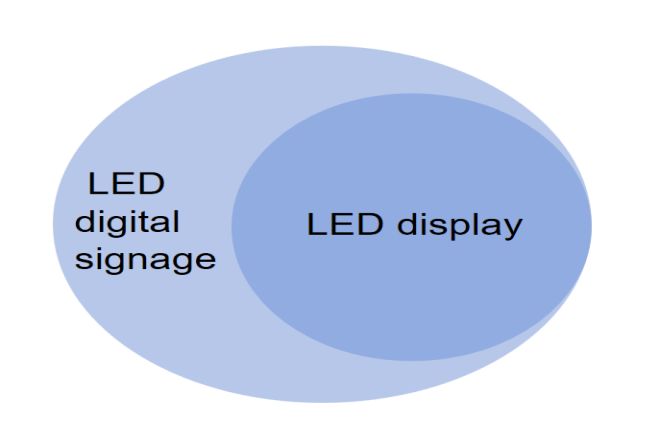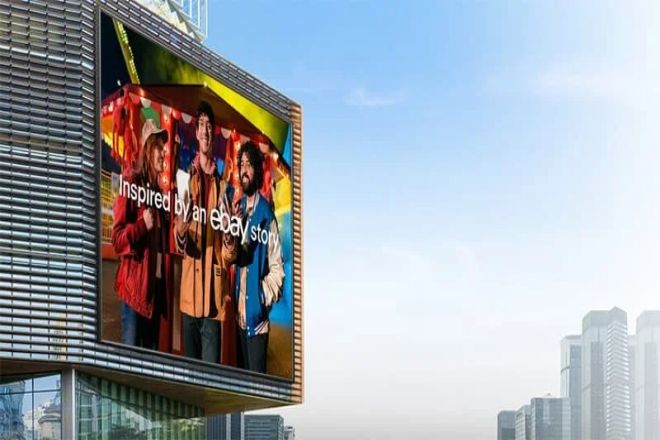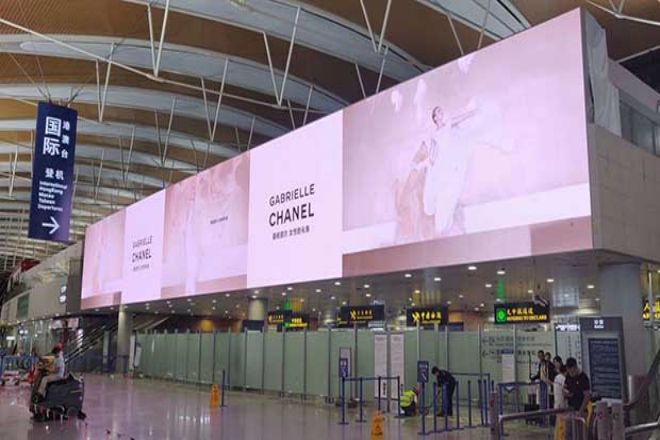Introduction

We often see the words LED display screen and LED digital signage in many articles, and they seem to say the same thing, which makes it difficult to distinguish between the two things.
Are they the same device? What is the connection between the two? Based on such questions, this article will take you to understand the relationship between LED digital signage and LED display screen. Let’s take a look.
1. Is LED digital signage an LED display screen?

LED digital signage is not completely equivalent to an LED display screen, but an LED display screen is an important part of LED digital signage.
LED digital signage is a new media concept that refers to a multimedia professional audio-visual system that publishes commercial, financial, and entertainment information through large-screen terminal display devices in public places such as large shopping malls, supermarkets, hotel lobbies, restaurants, and cinemas.
It is not just a display device but a complete system that integrates the control end, management end, network platform, playback end, and display terminal. Among them, the display terminal can be a variety of display devices, including LED display screens, LCD screens, plasma screens, etc.
As a display method that controls semiconductor light-emitting diodes (LEDs), LED display screens are composed of a large number of LED pixels arranged evenly. They have the advantages of high brightness, wide viewing angle, long life, and bright colors.
They are one of the commonly used display devices in LED digital signage. LED display screens can be customized in size, resolution, and brightness according to needs to adapt to different application scenarios, such as outdoor billboards, commercial windows, stage backgrounds, etc.
Therefore, although LED display screens are often used as display terminals in LED digital signage, the two are not completely equivalent. LED digital signage is a broader concept, which includes display devices, control systems, content management, and other aspects, and LED display screens are only a part of it.
In actual applications, LED digital signage systems will select appropriate display devices according to specific needs and realize remote editing, downloading, and updating of content through advanced control systems, thereby providing more flexible and efficient information dissemination solutions.
2. Explore the relationship between LED digital signage and LED display screens from all aspects

Explain the relationship between LED digital signage and LED display screens in a simple and easy-to-understand way.
1). Technical connection
1.1). The commonality of display technology
Imagine that LED digital signage and LED display screens are like two good friends. They both use a small bulb called a “light-emitting diode” (LED) to emit light. These small LED bulbs are like the paint of a painter.
By controlling whether they are bright or not and how bright they are, you can draw images, text, and videos on the screen. Therefore, whether it is digital signage or display screens, the basic principle of displaying information is the same.
1.2). Synchronicity of technological development
With the advancement of science and technology, LED display technology is becoming more and more advanced, just like the mobile phones we use. For example, now there is a small-pitch LED display screen, and its pixels are denser, just like painting with a thinner pen, so the picture is clearer, and the colors are brighter.
This technological advancement not only makes the LED display screen look more beautiful but also allows the LED digital signage system to display higher-quality content. At the same time, the control technology and content management of the LED digital signage system are also constantly improving, which in turn promotes the improvement of LED display technology. They are like racing together and promoting each other.
1.3). Tightness of system integration
The LED digital signage system is like a big team, which includes the “commander” responsible for control, the “editor” who manages the content, the “network” that transmits the information, and the “actor” (LED display) who finally displays it.
Each member of this team works closely together to accurately display the information to the audience. Therefore, as the “actor” in this system, the LED display screen works closely with other members to complete the transmission and display of information.
2). Complementarity at the application level
2.1). Complementarity of application scenarios
The LED display screen is like a large outdoor screen. Because of its high brightness and wide viewing angle, it is suitable for outdoor billboards, stadiums, and other places, so that many people can see it. The LED digital signage is more like an indoor “information expert”.
It can provide accurate information to people in need in shopping malls, supermarkets, hotel lobbies, and other places. The combination of the two can cover more places and meet the needs of more people.
2.2). Complementarity of functional realization
The LED digital signage system is not only a “display,” but it is also a “smart housekeeper.” It can remotely edit and update the display content and perform data analysis.
The LED display is like the “face” of this “smart housekeeper,” responsible for displaying the edited content with the best effect. In this way, the two can cooperate with each other to achieve more functions and meet more needs.
3). Market and development trends
3.1). Continuous growth of market size
With the rapid development of advertising, media, and commercial display, the demand for LED displays and digital signage is also increasing. Just like when we buy TVs, people like large-screen and high-definition products more and more, so the market for LED displays and digital signage is also growing.
3.2). Continuous promotion of technological innovation
Technological innovation is like giving LED displays and digital signage “wings” to let them fly higher and farther. For example, the emergence of new materials and new technologies makes the picture quality of LED displays better and the life longer.
The innovation of digital signage systems makes content management more convenient and data analysis more accurate. These innovations not only improve the performance of products but also bring more opportunities to the market.
3.3). Diversification of market demand
Now, people’s needs are becoming more and more diversified, and the application fields of LED displays and digital signage are becoming wider and wider. In addition to traditional outdoor advertising and commercial windows, they have also begun to enter education, medical care, transportation, and other fields.
This diversified demand not only brings new growth points to the market but also promotes the continuous upgrading and improvement of related technologies.
3. What are the future development forecasts for LED digital signage and LED display screens?

The future development forecasts for LED digital signage and LED display screens can be analyzed from multiple aspects, including technology trends, market demand, application scenario expansion, and policy support. The following are some predictions for the future development of the two:
1). Technology trends
- High definition and miniaturization:
With the advancement of technology, the resolution of LED display screens will continue to improve, achieving higher-definition picture displays.
At the same time, the development of new display technologies such as Mini LED and Micro LED will promote the development of LED display screens in the direction of miniaturization, further reduce the pixel pitch, and improve the display effect.
These technological trends will also promote the improvement of the display quality of LED digital signage.
- Intelligence and interactivity:
In the future, LED digital signage will be more intelligent, integrating more sensors and intelligent control modules to achieve interaction with the audience.
For example, personalized information push can be achieved through face recognition technology, and interactive operations can be achieved through gesture recognition technology.
This improvement in intelligence and interactivity will enhance the attractiveness and practicality of LED digital signage.
- Energy conservation, environmental protection, and sustainability:
With the global emphasis on environmental protection and sustainable development, LED display screens and LED digital signage will make more progress in energy conservation and environmental protection. For example, adopt more efficient LED chips, optimize circuit design, improve energy utilization, and other measures to reduce energy consumption and carbon emissions.
2). Market demand
- Advertising and media fields:
With the continuous expansion of the advertising market and the diversification of media forms, the demand for LED digital signage and LED display screens in the advertising and media fields will continue to grow.
Especially in outdoor advertising, commercial displays, event sites, etc., LED display screens are favored for their high brightness, wide viewing angle, and easy maintenance, while LED digital signage has become an important means of business promotion with its flexible and changeable information display methods and powerful content management capabilities.
- Smart city and Internet of Things:
With the advancement of smart city construction and the development of Internet of Things technology, LED digital signage and LED display screens will play a greater role in urban management and public services.
For example, LED display screens are used in traffic guidance, information release, environmental monitoring, etc.; LED digital signage is used in smart retail, smart security, and other fields to achieve accurate information push and intelligent management.
3). Application scenario expansion
- New retail and e-commerce:
With the rise of new retail and e-commerce, LED digital signage will play an important role in the integration of physical stores and online platforms.
Attract customer attention by updating product information, promotional activities, and other content in real time; at the same time, use big data to analyze customer behavior preferences to achieve precision marketing.
- Education and training:
In the field of education, LED digital signage can be used in campus information release, classroom interactive teaching, and other aspects to improve teaching efficiency and fun; in the field of training, it can be used in scenarios such as remote teaching and virtual laboratories to achieve sharing and optimal allocation of educational resources.
- Culture, art, and entertainment:
In the field of culture and art, LED digital signage and LED display screens can be used in museum exhibitions, art installations, concert stages, and other aspects to show unique visual effects and creative expressions; in the field of entertainment, they can be used in KTV boxes, bars, and other places to create an atmosphere and enhance customer experience.
Conclusion
In summary, LED digital signage and LED display screens play an important role in the field of modern information dissemination. The relationship between them is not only a combination of technology and application but also a symbiosis of market and industrial development.
With the continuous advancement of technology and the increasing market expansion, we have reason to believe that LED digital signage and LED display screens will show their unlimited potential in more fields and jointly write a new chapter in information dissemination.
Finally, if you want to know more about LED display screens, please get in touch with us.
